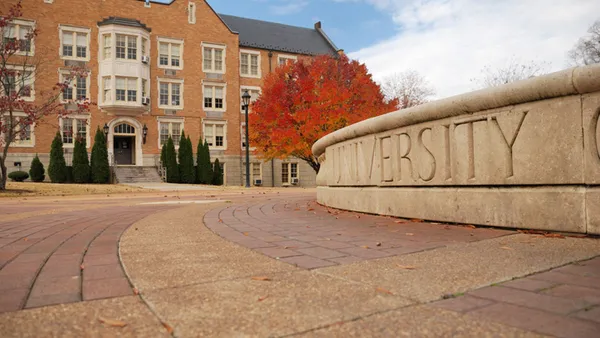Dive Brief:
-
Business costs for U.S. colleges rose 1.9% in the 2020 fiscal year, according to data from a report tracking the sector's inflation rate.
-
That marks a decline from a rate of 3% in 2019 and the five-year average of 2.4%, reported Commonfund, an investment management firm that publishes the Higher Education Price Index each year.
-
Though the report sheds some light on how the coronavirus crisis is affecting costs for colleges, much of the pandemic's impact on institutions occurred in the 2021 fiscal year.
Dive Insight:
The pandemic picked up in the U.S. in March, limiting its effect on the 2020 fiscal year. "While the virus burst onto the scene with major impact, inflation — the long-term focus of this report — is one whose true effects are felt more gradually," George Suttles, the Commonfund Institute's executive director, wrote in the report.
Commonfund bills HEPI as a more accurate way to capture higher education operational cost increases than using the U.S. consumer price index, which puts the nation's inflation rate at 1.6% in the 2020 fiscal year, minus food and energy costs. The gap between the HEPI and CPI rates is smaller in the 2020 fiscal year than it has been historically, Commonfund noted.
HEPI's two most heavily weighted components, faculty salaries and clerical costs, rose 2.7% and 3.2%, respectively, in the 2020 fiscal year.
Meanwhile, costs for service employees rose 4%, which is in line with the prior year's increase. This category's average five-year rate, at 3.4%, is the highest among the eight that Commonfund tracks.
Of these categories, half were above their five-year average in 2020. For instance, cost increases for clerical salaries and fringe benefits were higher than their five-year averages, while those for faculty and administrative salaries were lower.
Faculty salaries grew at a slower rate than national inflation from the Great Recession until the 2015-16 academic year, according to the American Association of University Professors. Although they have since kept pace, some colleges are laying off faculty or reducing their pay as part of pandemic-related budget cuts.
Utility costs had the greatest deviation, declining 15.7% compared to the five-year average change of -3.7%, though it has been a volatile category. And costs for supplies and materials fell 3.5%, a sharper drop than the category's five-year average rate of -0.1%.

Cost increases also vary by region and institution type, according to the data. Inflation rates ranged from 0.6% in Middle Atlantic states to 3.6% in the West North Central region, which includes Iowa, Kansas and Nebraska.

Faculty salary increases also differed. Among private colleges, they rose 3.7% at doctoral institutions, though only 0.6% and 1.7%, respectively, at master's and baccalaureate institutions.
Doctoral institutions also saw the largest increases in faculty salaries among public colleges, at 3.1%. Meanwhile, they rose 0.6% at two-year colleges and 1.4% at master's degree-granting institutions.















